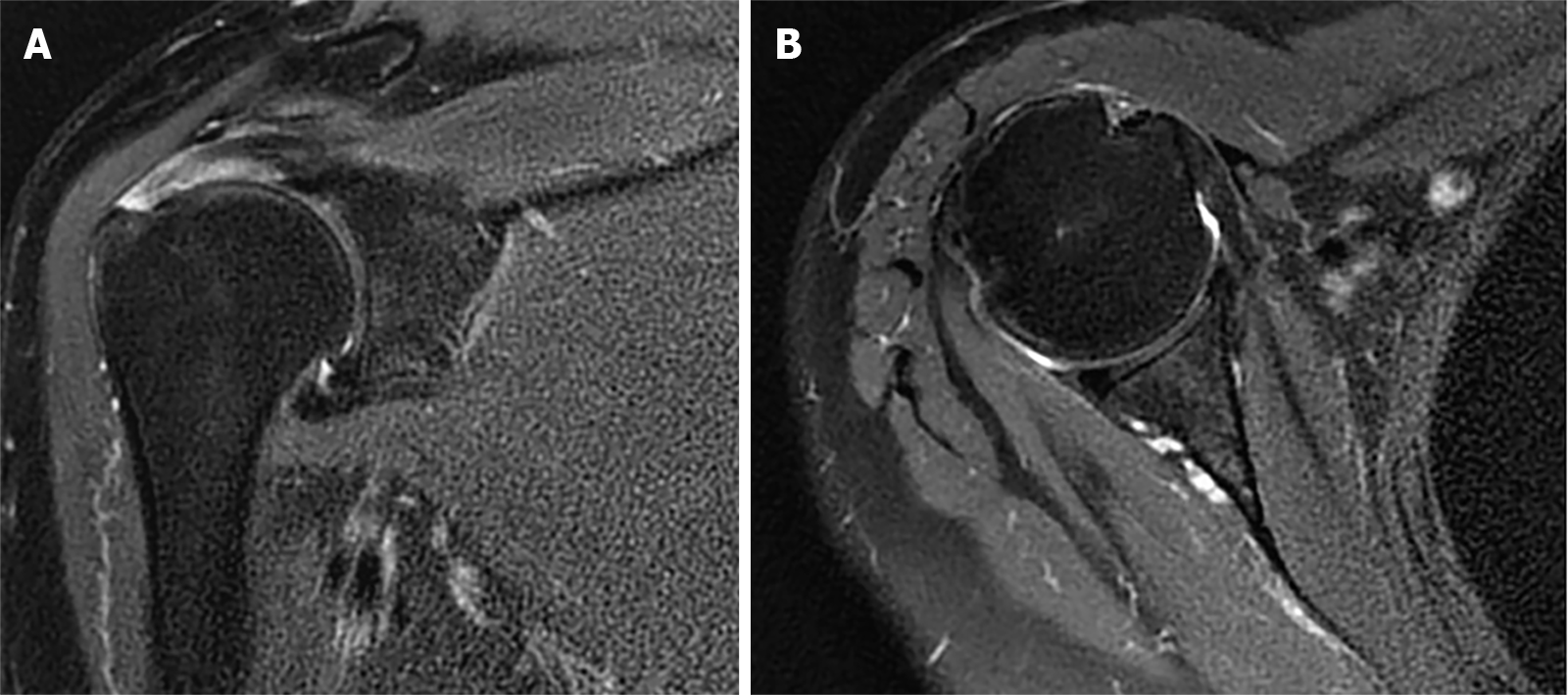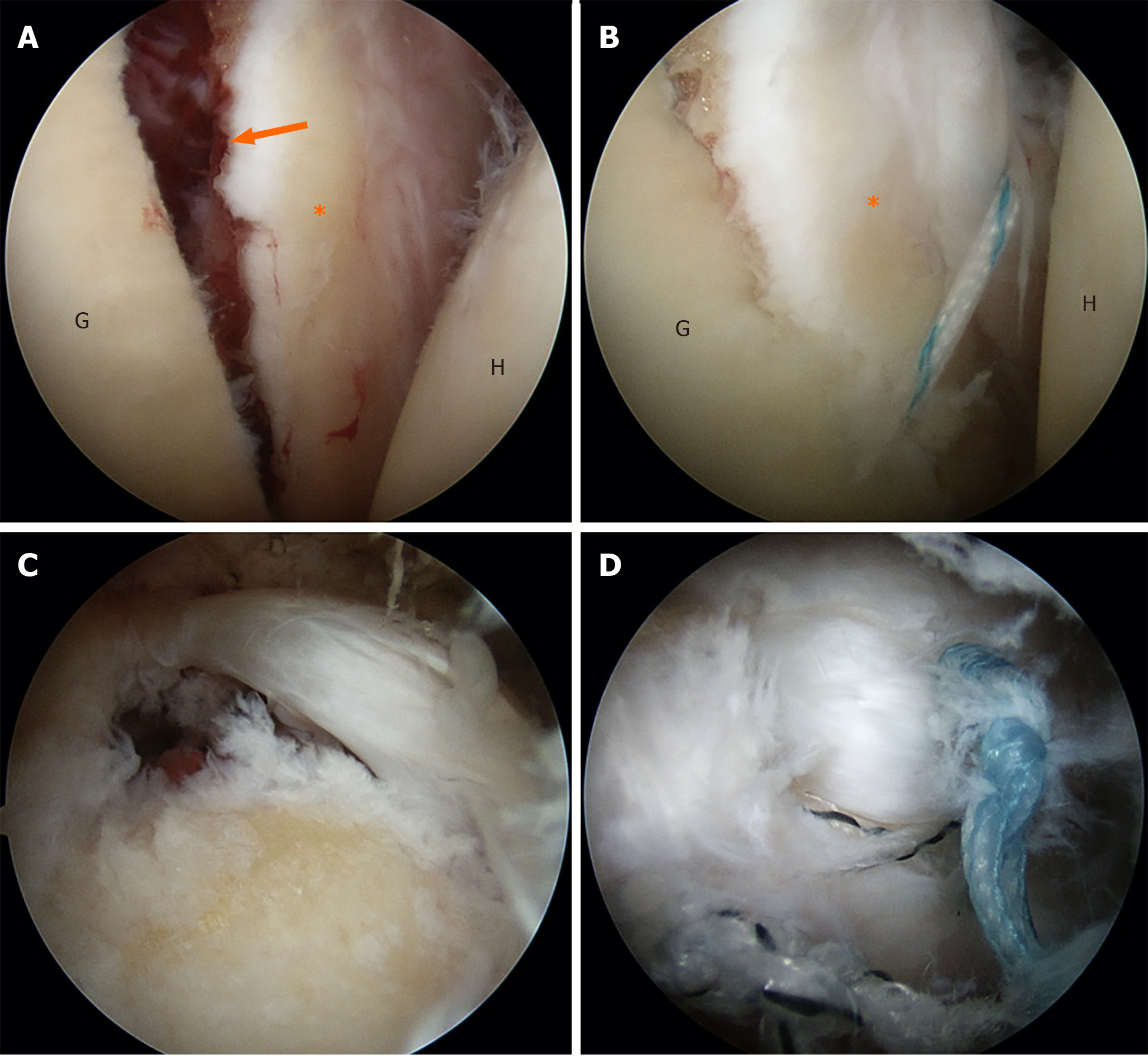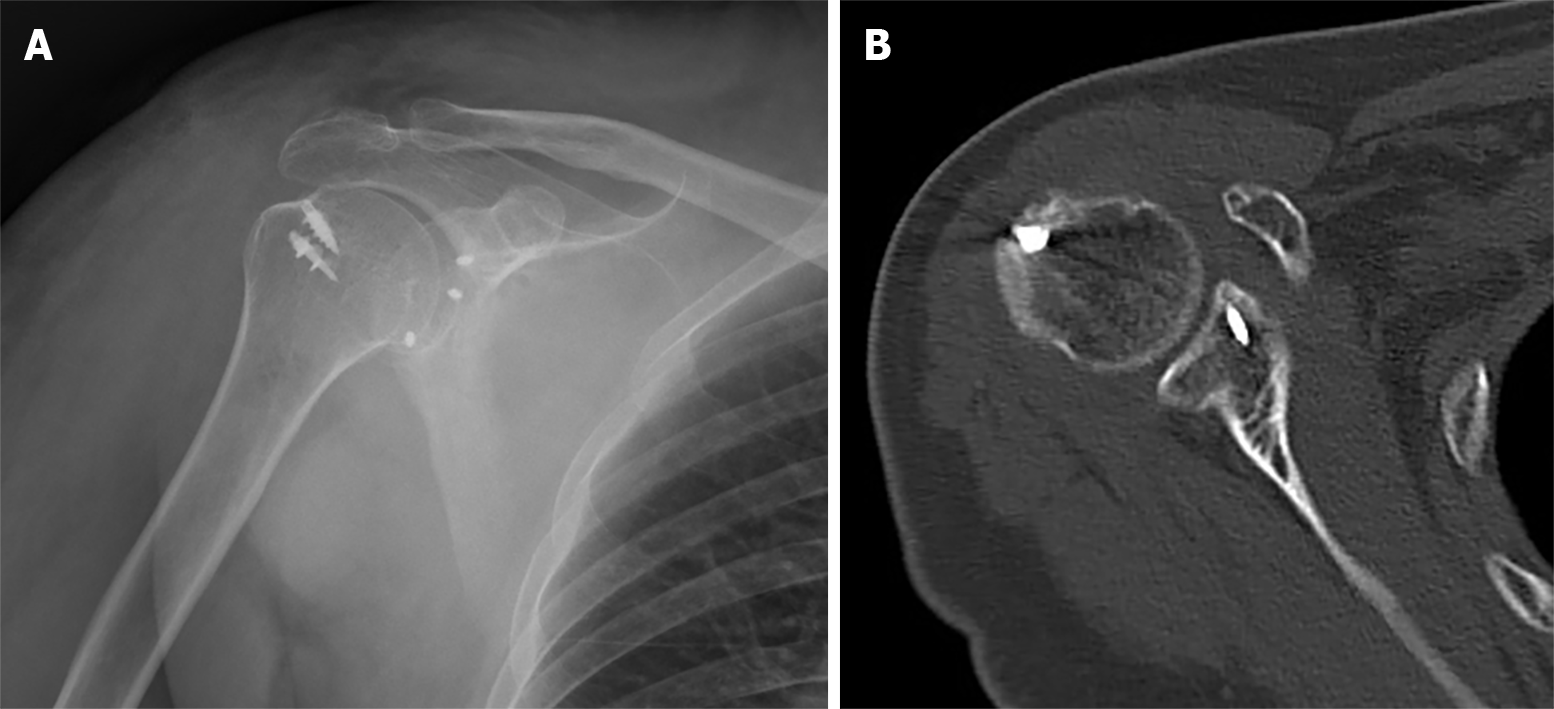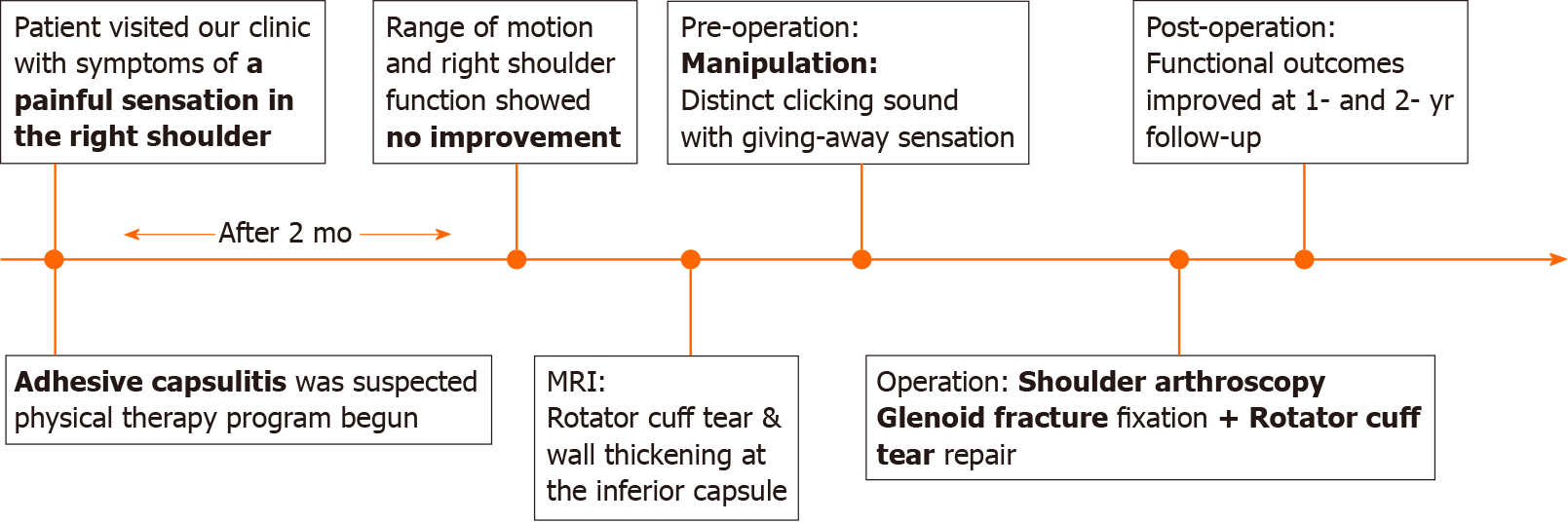Published online Nov 18, 2020. doi: 10.5312/wjo.v11.i11.516
Peer-review started: March 2, 2020
First decision: September 11, 2020
Revised: September 22, 2020
Accepted: October 9, 2020
Article in press: October 9, 2020
Published online: November 18, 2020
Processing time: 257 Days and 9.8 Hours
The brisement manipulation is an effective treatment for refractory shoulder stiffness. Rotator cuff tears can sometimes exist in combination with adhesive capsulitis. Arthroscopic capsular release combined with rotator cuff repair has achieved good outcomes in published reports.
We report the case of a patient with right shoulder pain for more than 1 year that was suspected to have adhesive capsulitis and a rotator cuff tear that was treated with brisement manipulation and arthroscopic management. An iatrogenic glenoid fracture with shoulder instability occurred during the manipulation. Arthroscopic treatment for fracture fixation, capsular release, and rotator cuff repair was performed, and the functional results are reported.
Arthroscopic fixation for iatrogenic glenoid fracture and repairing coexisting rotator cuff tear can provide the stability needed for early rehabilitation.
Core Tip: Manipulation under anesthesia is an effective treatment for refractory stiff shoulder, but some severe complications have been reported. We present a rare case of rotator cuff tear and antero-inferior glenoid rim fracture combined with shoulder instability after manipulation for shoulder stiffness. Arthroscopic repair of the glenoid fracture and concomitant rotator cuff tear was performed. A good outcome was achieved with this treatment in the 2-year postoperative follow-ups.
- Citation: Chiang CH, Tsai TC, Tung KK, Chih WH, Yeh ML, Su WR. Treatment of a rotator cuff tear combined with iatrogenic glenoid fracture and shoulder instability: A rare case report . World J Orthop 2020; 11(11): 516-522
- URL: https://www.wjgnet.com/2218-5836/full/v11/i11/516.htm
- DOI: https://dx.doi.org/10.5312/wjo.v11.i11.516
Rotator cuff tears accompanied by adhesive capsulitis are common in clinical practice[1-3]. Both problems are prevalent causes of shoulder pain and disability. Manipulation under anesthesia with or without arthroscopic capsular release is an effective operative treatment for a refractory stiff shoulder[3-6]. Rotator cuff repair combined with capsular release can achieve a good functional outcome with a low retear rate[7]. Some severe complications have been reported after the manipulation (e.g., humeral fracture, glenohumeral dislocation, and brachial plexus injury)[3,8]. Therefore, performing an arthroscopic capsular release before a shoulder manipulation is suggested to decrease the incidence of complications[3,9,10]. However, some surgeons still prefer to perform the manipulation before arthroscopy to facilitate the performance of the arthroscopy, and the use of an arthroscope after manipulation could increase the release and address any concomitant problems[9-12]. Furthermore, a high rate of iatrogenic intraarticular damage may occur during the manipulation[13]. The incidence of glenoid fracture after manipulation is rare, according to historical reports[8,14,15]. We present a case of antero-inferior glenoid rim fracture combined with shoulder instability after manipulation for shoulder stiffness. Arthroscopic repair of the glenoid fracture and concomitant rotator cuff tear was performed. A good outcome was achieved with this treatment. Informed consent was obtained from the patient, and she gave permission for her case to be published.
A 58-year-old woman presented to our clinic with a history of right shoulder pain and decreased range of motion (ROM) for more than 1 year.
She had a history of diabetes mellitus and was treated with oral diabetic medication. Adhesive capsulitis was suspected, and a physical therapy program was arranged to increase passive motion. Unfortunately, the ROM and right shoulder function showed no improvement after 2 mo of rehabilitation (Table 1).
| Before surgery | 1-yr follow-up | 2-yr follow-up | |
| VAS at rest | 5 | 2 | 1 |
| VAS during activity | 8 | 3 | 2 |
| ASES score | 20.0 | 80 | 85.0 |
| UCLA shoulder score | 10 | 30 | 31 |
| Range of motion in o | |||
| FE | 130 | 160 | 175 |
| ER, arm at side | 50 | 70 | 70 |
| ER, arm at 90° abduction | 60 | 85 | 90 |
| IR, arm at side | Buttock level | L1 level | T10 level |
| IR, arm at 90° abduction | 10 | 60 | 70 |
| Abduction | 120 | 150 | 160 |
She denied history of trauma of the right shoulder. She had a history of diabetes mellitus and was treated with oral diabetic medication.
The patient herself and her family had not suffer from this symptom before.
There were positive findings for the Hawkin’s and empty can tests. The decreased ROM function is described in Table 1.
All laboratory tests revealed no significant result.
A magnetic resonance imaging assessment revealed a small-sized full-thickness supraspinatus tear and wall thickening at the inferior capsule of the shoulder. No fractures were identified in the preoperative image evaluation (Figure 1).
Before operation, the tentative diagnosis was small-sized full-thickness supraspinatus tear and adhesive capsulitis. After manipulation, the final diagnosis was shifted to small-sized full-thickness supraspinatus tear combined with the glenoid fracture and shoulder instability.
She was given general anesthesia and placed in the supine position. Brisement manipulation was first performed and begun with forward flexion in internal rotation with light traction, which held the arm close to the axilla to decrease the lever effect. Continuous gentle pressure was applied, and a distinct clicking sound with a giving-way sensation was noted mid-way when the arm elevation was at 150 degrees. The X-ray was checked, and no proximal humeral fracture or dislocation was found. Then, manipulation for abduction, external rotation, and internal rotation was performed. After the manipulation, an examination revealed grade II laxity during anterior translation for the right shoulder[16].
Shoulder arthroscopy was then performed with the patient in the beach-chair position, starting from the standard posterior portal. A fresh fracture of the anteroinferior rim of the glenoid was noted (Figure 2). The size of the fragment was measured by a laser-marked device about 5 mm and 15 mm in the anterior-posterior and superior-inferior directions, respectively. Due to hypermobile anterior translation of the glenohumeral joint, fracture fixation was decided. Anteroinferior and accessory anterosuperior portals were established via an outside-in technique. Three 2.8-mm Twinfix Ti suture anchors (Smith & Nephew, Andover, MA, United States) were set in place at the lower edge, upper edge, and middle of the fractured glenoid for fixation of the fractured glenoid rim (Figure 2). After fracture fixation, the anterior translation test found no instability. Then, a complete capsular release was performed arthroscopically[8]. Repeated examinations showed good stability with full ROM. The fixed glenoid fracture was checked again arthroscopically and showed good stability with no displacement. Arthroscopic rotator cuff repair was then performed by two 5.0-mm Twinfix Ti suture anchors (Smith & Nephew) as the double-row suture technique in the subacromial space (Figure 2).
After surgery, the patient was immobilized in a simple sling, and gentle passive pendulum exercise was allowed for 6 wk, followed by active-assisted ROM exercises coupled with a comprehensive strengthening program. A computed tomography scan revealed healing of the fracture 3 mo after surgery (Figure 3). More aggressive training for strengthening and overhead lifting began from month 4, in accordance with the recovery of ROM and strength.
At the 1-year and 2-year postoperative follow-ups, functional outcomes had improved beyond the baseline preoperative measures, and the patient was satisfied with the surgical outcome (Table 1 and Figure 4).
Manipulation under anesthesia or arthroscopic capsular release is effective in treating a refractory stiff shoulder. For cases with coexisting rotator cuff tears, arthroscopic capsular release for the stiff shoulder combined with repair for the rotator cuff tear can achieve a good result[7]. Therefore, in cases of a stiff shoulder combined with a rotator cuff tear, surgeons can use an arthroscope to evaluate and address possible injuries and to perform additional capsular release, in addition to the manipulation procedure. Although there was no evidence to show that aggressive treatment for the coexisting problems could achieve a better outcome than manipulation only, it is reasonable to suggest that a better outcome can be achieved if all the problems can be treated in a minimally invasive manner, rather than with open surgery. This kind of aggressive treatment would be more suitable for patients with a strong motivation for rehabilitation and would result in a shorter treatment time than treating both of the problems separately or nonoperatively[1].
The management of the glenoid fracture remained controversial. Magnussen et al[17] reported a case with glenoid fracture during manipulation. The fracture healed only after immobilization without any surgical treatment. On the other hand, glenoid rim fractures often lead to chronic shoulder instability, and avulsion fractures of more than 5 mm with the instability of the glenohumeral joint may require operative stabilization[18,19]. Patients with glenoid fracture treated with arthroscopic anchor or screw fixation can also achieve uneventful healing and good functional results[20]. Arthroscopic fixation for glenoid fracture can minimize soft tissue dissection and manipulation. Additionally, with stable fixation and a reduced glenoid fossa, early rehabilitation can be allowed, complications related to malunion can be avoided, and good functional outcomes are more likely.
The reported results for arthroscopic repair of rotator cuff tears only and of tears combined with Bankart lesions have been similar and good[21,22]. The conditions in our case may be similar to those of a rotator cuff tear combined with a Bankart lesion. The treatment for both sites may have outcomes similar to those of rotator cuff repair only. Although the results are affected by capsule release, we would be more confident in allowing the patient to begin early motion rehabilitation if the glenoid fracture could be fixed together with the rotator cuff.
We would like to suggest that surgeons who experience a giving-way sensation after an obvious popping sound perform a radiographic check-up or an arthroscopic exam. Additionally, shoulder instability tests could be performed to evaluate possible instability. Arthroscopic fixation for an iatrogenic glenoid fracture and repair of a coexisting rotator cuff tear can provide stability needed for early rehabilitation. Fracture healing and good functional outcomes can be achieved.
We thank Huang HK, MD and Lin CH, MS (Department of Orthopaedics, Ditmanson Medical Foundation Chia-Yi Christian Hospital, Chiayi, Taiwan) for assistance with this case report.
Manuscript source: Unsolicited manuscript
Specialty type: Orthopedics
Country/Territory of origin: Taiwan
Peer-review report’s scientific quality classification
Grade A (Excellent): 0
Grade B (Very good): B, B, B
Grade C (Good): C
Grade D (Fair): 0
Grade E (Poor): 0
P-Reviewer: Halabchi F, Wang X, Zacharia B, Zhu SH S-Editor: Zhang H L-Editor: Filipodia P-Editor: Li X
| 1. | Le HV, Lee SJ, Nazarian A, Rodriguez EK. Adhesive capsulitis of the shoulder: review of pathophysiology and current clinical treatments. Shoulder Elbow. 2017;9:75-84. [RCA] [PubMed] [DOI] [Full Text] [Cited by in Crossref: 135] [Cited by in RCA: 219] [Article Influence: 27.4] [Reference Citation Analysis (0)] |
| 2. | Zhang K, de Sa D, Kanakamedala A, Sheean AJ, Vyas D. Management of Concomitant Preoperative Rotator Cuff Pathology and Adhesive Capsulitis: A Systematic Review of Indications, Treatment Approaches, and Outcomes. Arthroscopy. 2019;35:979-993. [RCA] [PubMed] [DOI] [Full Text] [Cited by in Crossref: 10] [Cited by in RCA: 14] [Article Influence: 2.3] [Reference Citation Analysis (0)] |
| 3. | Redler LH, Dennis ER. Treatment of Adhesive Capsulitis of the Shoulder. J Am Acad Orthop Surg. 2019;27:e544-e554. [RCA] [PubMed] [DOI] [Full Text] [Cited by in Crossref: 45] [Cited by in RCA: 80] [Article Influence: 13.3] [Reference Citation Analysis (0)] |
| 4. | Uppal HS, Evans JP, Smith C. Frozen shoulder: A systematic review of therapeutic options. World J Orthop. 2015;6:263-268. [RCA] [PubMed] [DOI] [Full Text] [Full Text (PDF)] [Cited by in CrossRef: 80] [Cited by in RCA: 88] [Article Influence: 8.8] [Reference Citation Analysis (5)] |
| 5. | Arce G. Primary Frozen Shoulder Syndrome: Arthroscopic Capsular Release. Arthrosc Tech. 2015;4:e717-e720. [RCA] [PubMed] [DOI] [Full Text] [Cited by in Crossref: 12] [Cited by in RCA: 14] [Article Influence: 1.4] [Reference Citation Analysis (0)] |
| 6. | Kraal T, The B, Boer R, van den Borne MP, Koenraadt K, Goossens P, Eygendaal D. Manipulation under anesthesia vs physiotherapy treatment in stage two of a frozen shoulder: a study protocol for a randomized controlled trial. BMC Musculoskelet Disord. 2017;18:412. [RCA] [PubMed] [DOI] [Full Text] [Full Text (PDF)] [Cited by in Crossref: 18] [Cited by in RCA: 15] [Article Influence: 1.9] [Reference Citation Analysis (0)] |
| 7. | McGrath JP, Lam PH, Tan MT, Murrell GA. The effect of concomitant glenohumeral joint capsule release during rotator cuff repair--a comparative study. J Shoulder Elbow Surg. 2016;25:714-722. [RCA] [PubMed] [DOI] [Full Text] [Cited by in Crossref: 26] [Cited by in RCA: 30] [Article Influence: 3.3] [Reference Citation Analysis (0)] |
| 8. | Hsu JE, Anakwenze OA, Warrender WJ, Abboud JA. Current review of adhesive capsulitis. J Shoulder Elbow Surg. 2011;20:502-514. [RCA] [PubMed] [DOI] [Full Text] [Cited by in Crossref: 216] [Cited by in RCA: 228] [Article Influence: 16.3] [Reference Citation Analysis (0)] |
| 9. | Ogilvie-Harris DJ, Biggs DJ, Fitsialos DP, MacKay M. The resistant frozen shoulder. Manipulation vs arthroscopic release. Clin Orthop Relat Res. 1995;238-248. [RCA] [PubMed] [DOI] [Full Text] [Cited by in Crossref: 13] [Cited by in RCA: 13] [Article Influence: 0.4] [Reference Citation Analysis (0)] |
| 10. | Celik H, Seckin MF, Akcal MA, Kara A, Kilinc BE, Akman S. Mid-long term results of manipulation and arthroscopic release in frozen shoulder. Acta Ortop Bras. 2017;25:270-274. [RCA] [PubMed] [DOI] [Full Text] [Full Text (PDF)] [Cited by in Crossref: 3] [Cited by in RCA: 3] [Article Influence: 0.4] [Reference Citation Analysis (0)] |
| 11. | Giuseffi S, Field LD, Giel TV 3rd, Brislin BT, Savoie FH 3rd. Arthroscopic Rotator Cuff Repair With Concomitant Capsular Release. Arthrosc Tech. 2016;5:e833-e837. [RCA] [PubMed] [DOI] [Full Text] [Cited by in Crossref: 9] [Cited by in RCA: 9] [Article Influence: 1.0] [Reference Citation Analysis (0)] |
| 12. | Grant JA, Schroeder N, Miller BS, Carpenter JE. Comparison of manipulation and arthroscopic capsular release for adhesive capsulitis: a systematic review. J Shoulder Elbow Surg. 2013;22:1135-1145. [RCA] [PubMed] [DOI] [Full Text] [Cited by in Crossref: 75] [Cited by in RCA: 75] [Article Influence: 6.3] [Reference Citation Analysis (0)] |
| 13. | Loew M, Heichel TO, Lehner B. Intraarticular lesions in primary frozen shoulder after manipulation under general anesthesia. J Shoulder Elbow Surg. 2005;14:16-21. [RCA] [PubMed] [DOI] [Full Text] [Cited by in Crossref: 148] [Cited by in RCA: 120] [Article Influence: 6.0] [Reference Citation Analysis (0)] |
| 14. | Koh KH, Kim JH, Yoo JC. Iatrogenic glenoid fracture after brisement manipulation for the stiffness of shoulder in patients with rotator cuff tear. Eur J Orthop Surg Traumatol. 2013;23 Suppl 2:S175-S178. [RCA] [PubMed] [DOI] [Full Text] [Cited by in Crossref: 5] [Cited by in RCA: 5] [Article Influence: 0.4] [Reference Citation Analysis (0)] |
| 15. | Ji JH, Park SE, Kim WY, Min HK, Lee SW. Arthroscopic fixation of iatrogenic glenoid rim fracture caused by brisement manipulation: Two case reports. J Orthop Sci. 2017;22:160-163. [RCA] [PubMed] [DOI] [Full Text] [Cited by in Crossref: 1] [Cited by in RCA: 1] [Article Influence: 0.1] [Reference Citation Analysis (0)] |
| 16. | Silliman JF, Hawkins RJ. Classification and physical diagnosis of instability of the shoulder. Clin Orthop Relat Res. 1993;7-19. [RCA] [PubMed] [DOI] [Full Text] [Cited by in Crossref: 70] [Cited by in RCA: 35] [Article Influence: 1.1] [Reference Citation Analysis (0)] |
| 17. | Magnussen RA, Taylor DC. Glenoid fracture during manipulation under anesthesia for adhesive capsulitis: a case report. J Shoulder Elbow Surg. 2011;20:e23-e26. [RCA] [PubMed] [DOI] [Full Text] [Cited by in Crossref: 24] [Cited by in RCA: 29] [Article Influence: 2.1] [Reference Citation Analysis (0)] |
| 18. | van Oostveen DP, Temmerman OP, Burger BJ, van Noort A, Robinson M. Glenoid fractures: a review of pathology, classification, treatment and results. Acta Orthop Belg. 2014;80:88-98. [PubMed] |
| 19. | Frich LH, Larsen MS. How to deal with a glenoid fracture. EFORT Open Rev. 2017;2:151-157. [RCA] [PubMed] [DOI] [Full Text] [Full Text (PDF)] [Cited by in Crossref: 12] [Cited by in RCA: 12] [Article Influence: 1.5] [Reference Citation Analysis (0)] |
| 20. | Qu F, Yuan B, Qi W, Li C, Shen X, Guo Q, Zhao G, Wang J, Li H, Lu X, Liu Y. Arthroscopic Fixation of Comminuted Glenoid Fractures Using Cannulated Screws and Suture Anchors. Medicine (Baltimore). 2015;94:e1923. [RCA] [PubMed] [DOI] [Full Text] [Full Text (PDF)] [Cited by in Crossref: 6] [Cited by in RCA: 4] [Article Influence: 0.4] [Reference Citation Analysis (0)] |
| 21. | Godinho GG, Freitas JM, de Oliveira França F, Santos FM, de Simoni LF, Godinho PC. Evaluation of functional results from shoulders after arthroscopic repair of complete rotator cuff tears associated with traumatic anterior dislocation. Rev Bras Ortop. 2016;51:163-168. [RCA] [PubMed] [DOI] [Full Text] [Full Text (PDF)] [Cited by in Crossref: 3] [Cited by in RCA: 4] [Article Influence: 0.4] [Reference Citation Analysis (0)] |
| 22. | Shields E, Mirabelli M, Amsdell S, Thorsness R, Goldblatt J, Maloney M, Voloshin I. Functional and imaging outcomes of arthroscopic simultaneous rotator cuff repair and bankart repair after shoulder dislocations. Am J Sports Med. 2014;42:2614-2620. [RCA] [PubMed] [DOI] [Full Text] [Cited by in Crossref: 11] [Cited by in RCA: 13] [Article Influence: 1.2] [Reference Citation Analysis (0)] |
| 23. | Richards RR, An KN, Bigliani LU, Friedman RJ, Gartsman GM, Gristina AG, Iannotti JP, Mow VC, Sidles JA, Zuckerman JD. A standardized method for the assessment of shoulder function. J Shoulder Elbow Surg. 1994;3:347-352. [RCA] [PubMed] [DOI] [Full Text] [Cited by in Crossref: 1180] [Cited by in RCA: 1266] [Article Influence: 40.8] [Reference Citation Analysis (0)] |
| 24. | Amstutz HC, Sew Hoy AL, Clarke IC. UCLA anatomic total shoulder arthroplasty. Clin Orthop Relat Res. 1981;(155):7-20. [RCA] [PubMed] [DOI] [Full Text] [Cited by in Crossref: 191] [Cited by in RCA: 197] [Article Influence: 4.5] [Reference Citation Analysis (0)] |












